Report on Managing Business Activities to Achieve Results
VerifiedAdded on 2020/02/03
|16
|4961
|25
Report
AI Summary
This report delves into the crucial aspects of managing business activities to achieve desired results. It explores the interrelationship between various organizational processes and functions, emphasizing the importance of effective process mapping to align activities with overall goals and objectives. The report examines quality gateways and output, outlining systems to monitor and manage quality standards. It also covers planning to promote goals, resource allocation, and implementing systems to achieve objectives. Furthermore, it addresses health and safety regulations, risk assessment, and organizational policies. The report emphasizes continuous monitoring, evaluation, and improvement to align with organizational objectives and goals. The report provides a comprehensive overview of key management principles and practices for achieving business success.
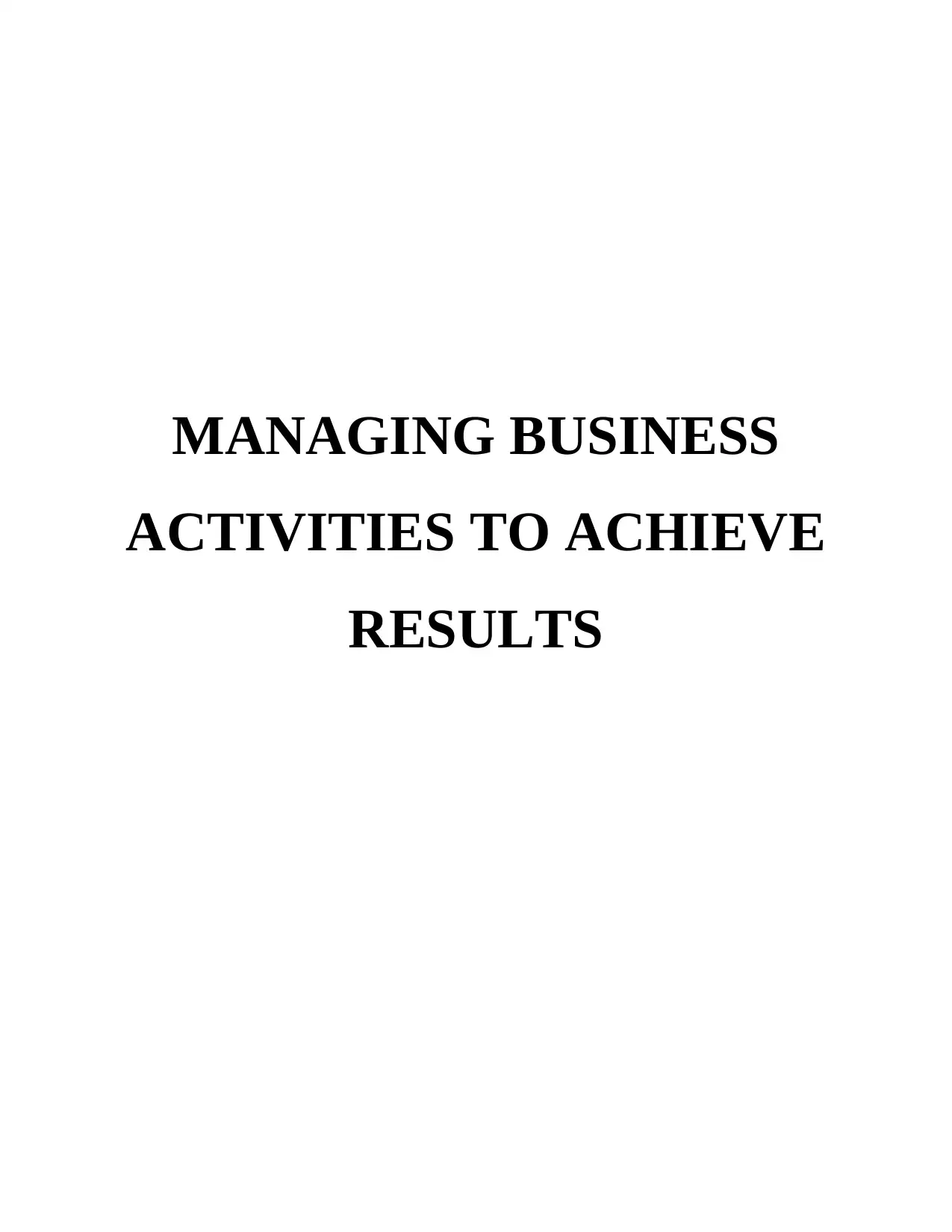
MANAGING BUSINESS
ACTIVITIES TO ACHIEVE
RESULTS
ACTIVITIES TO ACHIEVE
RESULTS
Paraphrase This Document
Need a fresh take? Get an instant paraphrase of this document with our AI Paraphraser
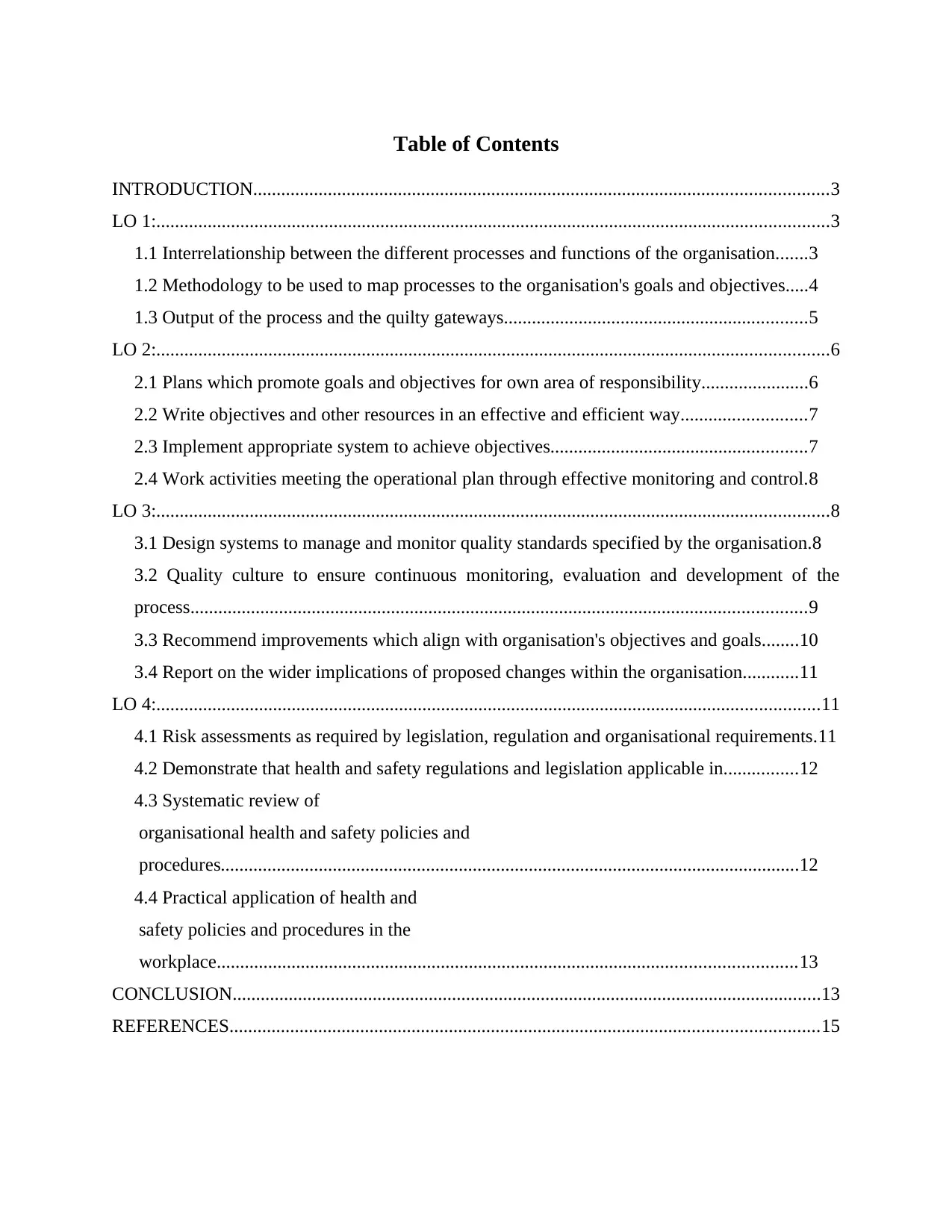
Table of Contents
INTRODUCTION...........................................................................................................................3
LO 1:................................................................................................................................................3
1.1 Interrelationship between the different processes and functions of the organisation.......3
1.2 Methodology to be used to map processes to the organisation's goals and objectives.....4
1.3 Output of the process and the quilty gateways.................................................................5
LO 2:................................................................................................................................................6
2.1 Plans which promote goals and objectives for own area of responsibility.......................6
2.2 Write objectives and other resources in an effective and efficient way...........................7
2.3 Implement appropriate system to achieve objectives.......................................................7
2.4 Work activities meeting the operational plan through effective monitoring and control.8
LO 3:................................................................................................................................................8
3.1 Design systems to manage and monitor quality standards specified by the organisation.8
3.2 Quality culture to ensure continuous monitoring, evaluation and development of the
process....................................................................................................................................9
3.3 Recommend improvements which align with organisation's objectives and goals........10
3.4 Report on the wider implications of proposed changes within the organisation............11
LO 4:..............................................................................................................................................11
4.1 Risk assessments as required by legislation, regulation and organisational requirements.11
4.2 Demonstrate that health and safety regulations and legislation applicable in................12
4.3 Systematic review of
organisational health and safety policies and
procedures............................................................................................................................12
4.4 Practical application of health and
safety policies and procedures in the
workplace............................................................................................................................13
CONCLUSION..............................................................................................................................13
REFERENCES..............................................................................................................................15
INTRODUCTION...........................................................................................................................3
LO 1:................................................................................................................................................3
1.1 Interrelationship between the different processes and functions of the organisation.......3
1.2 Methodology to be used to map processes to the organisation's goals and objectives.....4
1.3 Output of the process and the quilty gateways.................................................................5
LO 2:................................................................................................................................................6
2.1 Plans which promote goals and objectives for own area of responsibility.......................6
2.2 Write objectives and other resources in an effective and efficient way...........................7
2.3 Implement appropriate system to achieve objectives.......................................................7
2.4 Work activities meeting the operational plan through effective monitoring and control.8
LO 3:................................................................................................................................................8
3.1 Design systems to manage and monitor quality standards specified by the organisation.8
3.2 Quality culture to ensure continuous monitoring, evaluation and development of the
process....................................................................................................................................9
3.3 Recommend improvements which align with organisation's objectives and goals........10
3.4 Report on the wider implications of proposed changes within the organisation............11
LO 4:..............................................................................................................................................11
4.1 Risk assessments as required by legislation, regulation and organisational requirements.11
4.2 Demonstrate that health and safety regulations and legislation applicable in................12
4.3 Systematic review of
organisational health and safety policies and
procedures............................................................................................................................12
4.4 Practical application of health and
safety policies and procedures in the
workplace............................................................................................................................13
CONCLUSION..............................................................................................................................13
REFERENCES..............................................................................................................................15
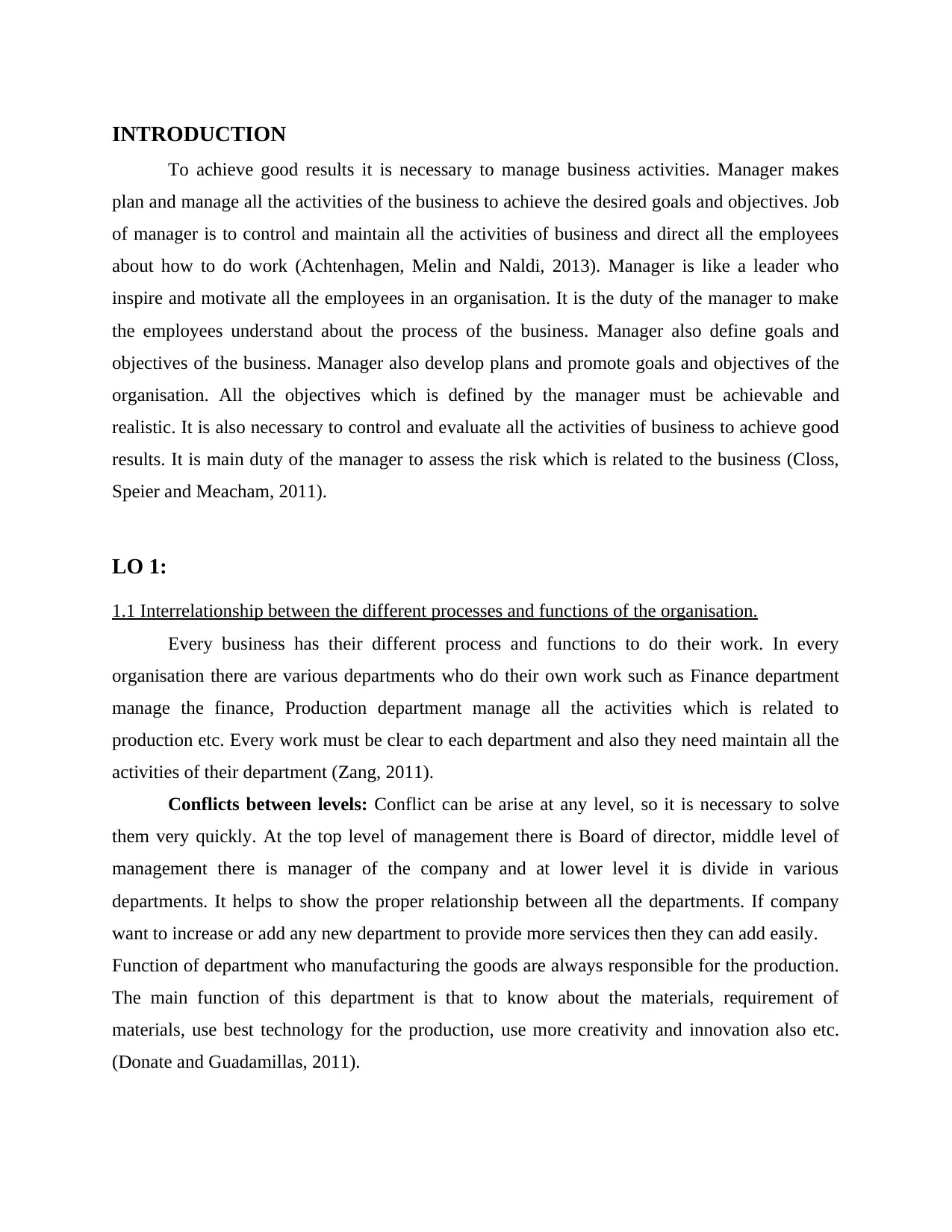
INTRODUCTION
To achieve good results it is necessary to manage business activities. Manager makes
plan and manage all the activities of the business to achieve the desired goals and objectives. Job
of manager is to control and maintain all the activities of business and direct all the employees
about how to do work (Achtenhagen, Melin and Naldi, 2013). Manager is like a leader who
inspire and motivate all the employees in an organisation. It is the duty of the manager to make
the employees understand about the process of the business. Manager also define goals and
objectives of the business. Manager also develop plans and promote goals and objectives of the
organisation. All the objectives which is defined by the manager must be achievable and
realistic. It is also necessary to control and evaluate all the activities of business to achieve good
results. It is main duty of the manager to assess the risk which is related to the business (Closs,
Speier and Meacham, 2011).
LO 1:
1.1 Interrelationship between the different processes and functions of the organisation.
Every business has their different process and functions to do their work. In every
organisation there are various departments who do their own work such as Finance department
manage the finance, Production department manage all the activities which is related to
production etc. Every work must be clear to each department and also they need maintain all the
activities of their department (Zang, 2011).
Conflicts between levels: Conflict can be arise at any level, so it is necessary to solve
them very quickly. At the top level of management there is Board of director, middle level of
management there is manager of the company and at lower level it is divide in various
departments. It helps to show the proper relationship between all the departments. If company
want to increase or add any new department to provide more services then they can add easily.
Function of department who manufacturing the goods are always responsible for the production.
The main function of this department is that to know about the materials, requirement of
materials, use best technology for the production, use more creativity and innovation also etc.
(Donate and Guadamillas, 2011).
To achieve good results it is necessary to manage business activities. Manager makes
plan and manage all the activities of the business to achieve the desired goals and objectives. Job
of manager is to control and maintain all the activities of business and direct all the employees
about how to do work (Achtenhagen, Melin and Naldi, 2013). Manager is like a leader who
inspire and motivate all the employees in an organisation. It is the duty of the manager to make
the employees understand about the process of the business. Manager also define goals and
objectives of the business. Manager also develop plans and promote goals and objectives of the
organisation. All the objectives which is defined by the manager must be achievable and
realistic. It is also necessary to control and evaluate all the activities of business to achieve good
results. It is main duty of the manager to assess the risk which is related to the business (Closs,
Speier and Meacham, 2011).
LO 1:
1.1 Interrelationship between the different processes and functions of the organisation.
Every business has their different process and functions to do their work. In every
organisation there are various departments who do their own work such as Finance department
manage the finance, Production department manage all the activities which is related to
production etc. Every work must be clear to each department and also they need maintain all the
activities of their department (Zang, 2011).
Conflicts between levels: Conflict can be arise at any level, so it is necessary to solve
them very quickly. At the top level of management there is Board of director, middle level of
management there is manager of the company and at lower level it is divide in various
departments. It helps to show the proper relationship between all the departments. If company
want to increase or add any new department to provide more services then they can add easily.
Function of department who manufacturing the goods are always responsible for the production.
The main function of this department is that to know about the materials, requirement of
materials, use best technology for the production, use more creativity and innovation also etc.
(Donate and Guadamillas, 2011).
⊘ This is a preview!⊘
Do you want full access?
Subscribe today to unlock all pages.

Trusted by 1+ million students worldwide
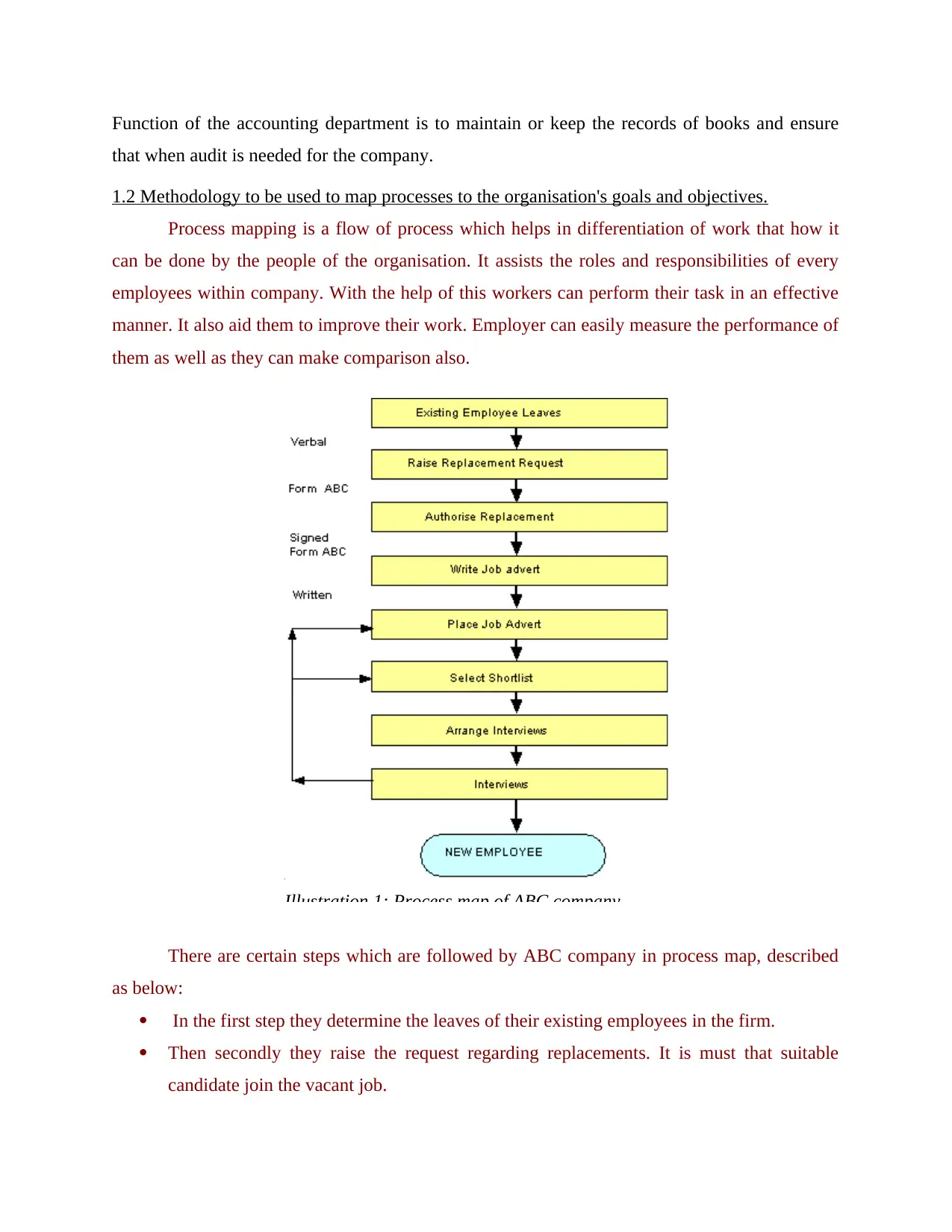
Function of the accounting department is to maintain or keep the records of books and ensure
that when audit is needed for the company.
1.2 Methodology to be used to map processes to the organisation's goals and objectives.
Process mapping is a flow of process which helps in differentiation of work that how it
can be done by the people of the organisation. It assists the roles and responsibilities of every
employees within company. With the help of this workers can perform their task in an effective
manner. It also aid them to improve their work. Employer can easily measure the performance of
them as well as they can make comparison also.
There are certain steps which are followed by ABC company in process map, described
as below:
In the first step they determine the leaves of their existing employees in the firm.
Then secondly they raise the request regarding replacements. It is must that suitable
candidate join the vacant job.
Illustration 1: Process map of ABC company
that when audit is needed for the company.
1.2 Methodology to be used to map processes to the organisation's goals and objectives.
Process mapping is a flow of process which helps in differentiation of work that how it
can be done by the people of the organisation. It assists the roles and responsibilities of every
employees within company. With the help of this workers can perform their task in an effective
manner. It also aid them to improve their work. Employer can easily measure the performance of
them as well as they can make comparison also.
There are certain steps which are followed by ABC company in process map, described
as below:
In the first step they determine the leaves of their existing employees in the firm.
Then secondly they raise the request regarding replacements. It is must that suitable
candidate join the vacant job.
Illustration 1: Process map of ABC company
Paraphrase This Document
Need a fresh take? Get an instant paraphrase of this document with our AI Paraphraser

The third step is that substitution must be authorised.
Then ABC company can post the advertisement which is related to the empty job. They
can use various tools for this purpose such as internet, LinkedIn etc.
In fifth step, manager of HR department must place the job advertisement to fulfil the
necessary requirements regarding job.
Candidates file their applications in the company on website etc., then employer shortlist
the suitable nominee.
Then they arrange the interview with the applicant weather it is face to face or
telephonic .
The final step is that they recruit the new employee for their company which helps in
attaining goals and objectives of the firm.
1.3 Output of the process and the quilty gateways.
Quality gateway mean when employee pass on the all the requirements which is essential.
In other words, company eliminate those candidates who are no appropriate for the company as
soon as possible so that they can prevent right people. The process regarding this is described as
below:
Illustration 2: Steps of quality gateway process
Then ABC company can post the advertisement which is related to the empty job. They
can use various tools for this purpose such as internet, LinkedIn etc.
In fifth step, manager of HR department must place the job advertisement to fulfil the
necessary requirements regarding job.
Candidates file their applications in the company on website etc., then employer shortlist
the suitable nominee.
Then they arrange the interview with the applicant weather it is face to face or
telephonic .
The final step is that they recruit the new employee for their company which helps in
attaining goals and objectives of the firm.
1.3 Output of the process and the quilty gateways.
Quality gateway mean when employee pass on the all the requirements which is essential.
In other words, company eliminate those candidates who are no appropriate for the company as
soon as possible so that they can prevent right people. The process regarding this is described as
below:
Illustration 2: Steps of quality gateway process
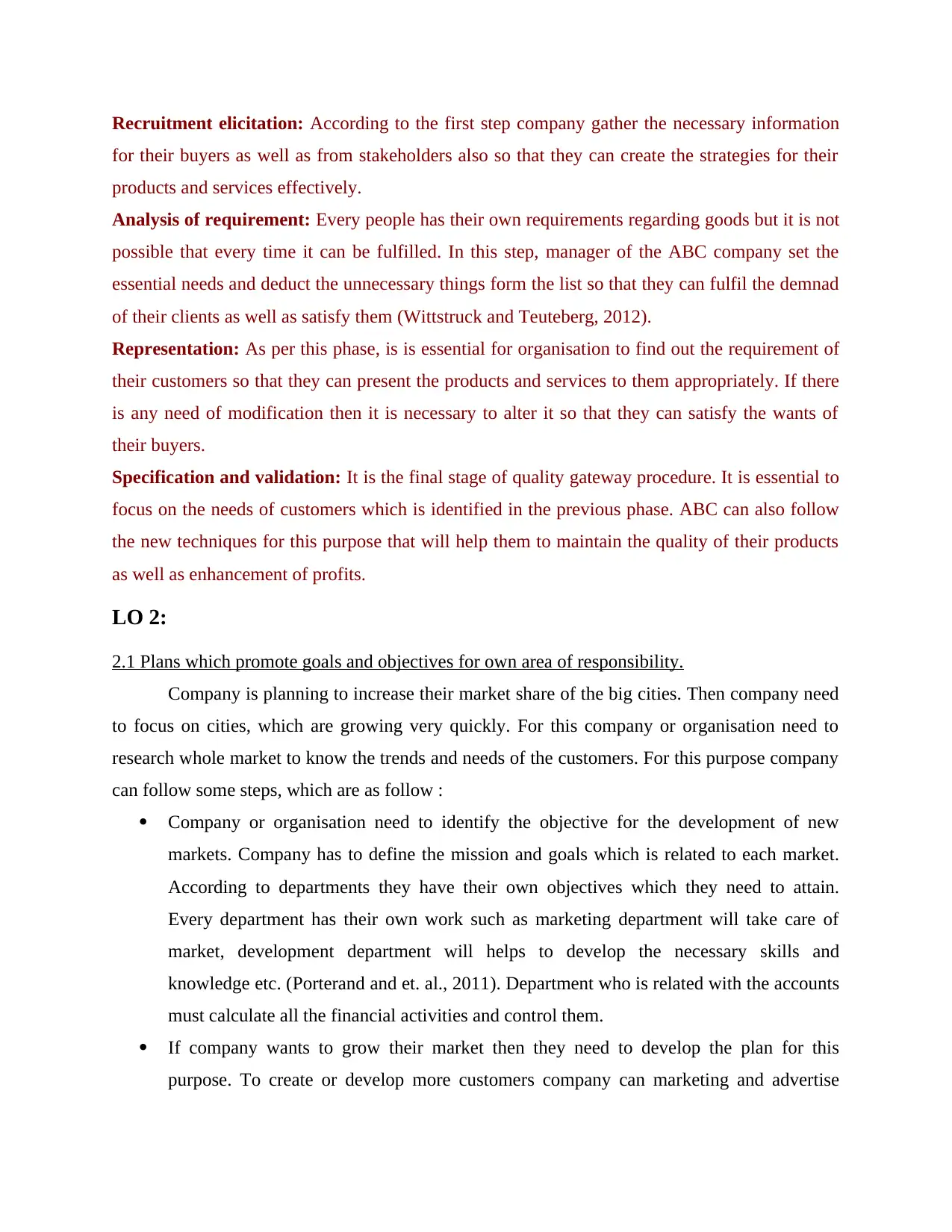
Recruitment elicitation: According to the first step company gather the necessary information
for their buyers as well as from stakeholders also so that they can create the strategies for their
products and services effectively.
Analysis of requirement: Every people has their own requirements regarding goods but it is not
possible that every time it can be fulfilled. In this step, manager of the ABC company set the
essential needs and deduct the unnecessary things form the list so that they can fulfil the demnad
of their clients as well as satisfy them (Wittstruck and Teuteberg, 2012).
Representation: As per this phase, is is essential for organisation to find out the requirement of
their customers so that they can present the products and services to them appropriately. If there
is any need of modification then it is necessary to alter it so that they can satisfy the wants of
their buyers.
Specification and validation: It is the final stage of quality gateway procedure. It is essential to
focus on the needs of customers which is identified in the previous phase. ABC can also follow
the new techniques for this purpose that will help them to maintain the quality of their products
as well as enhancement of profits.
LO 2:
2.1 Plans which promote goals and objectives for own area of responsibility.
Company is planning to increase their market share of the big cities. Then company need
to focus on cities, which are growing very quickly. For this company or organisation need to
research whole market to know the trends and needs of the customers. For this purpose company
can follow some steps, which are as follow :
Company or organisation need to identify the objective for the development of new
markets. Company has to define the mission and goals which is related to each market.
According to departments they have their own objectives which they need to attain.
Every department has their own work such as marketing department will take care of
market, development department will helps to develop the necessary skills and
knowledge etc. (Porterand and et. al., 2011). Department who is related with the accounts
must calculate all the financial activities and control them.
If company wants to grow their market then they need to develop the plan for this
purpose. To create or develop more customers company can marketing and advertise
for their buyers as well as from stakeholders also so that they can create the strategies for their
products and services effectively.
Analysis of requirement: Every people has their own requirements regarding goods but it is not
possible that every time it can be fulfilled. In this step, manager of the ABC company set the
essential needs and deduct the unnecessary things form the list so that they can fulfil the demnad
of their clients as well as satisfy them (Wittstruck and Teuteberg, 2012).
Representation: As per this phase, is is essential for organisation to find out the requirement of
their customers so that they can present the products and services to them appropriately. If there
is any need of modification then it is necessary to alter it so that they can satisfy the wants of
their buyers.
Specification and validation: It is the final stage of quality gateway procedure. It is essential to
focus on the needs of customers which is identified in the previous phase. ABC can also follow
the new techniques for this purpose that will help them to maintain the quality of their products
as well as enhancement of profits.
LO 2:
2.1 Plans which promote goals and objectives for own area of responsibility.
Company is planning to increase their market share of the big cities. Then company need
to focus on cities, which are growing very quickly. For this company or organisation need to
research whole market to know the trends and needs of the customers. For this purpose company
can follow some steps, which are as follow :
Company or organisation need to identify the objective for the development of new
markets. Company has to define the mission and goals which is related to each market.
According to departments they have their own objectives which they need to attain.
Every department has their own work such as marketing department will take care of
market, development department will helps to develop the necessary skills and
knowledge etc. (Porterand and et. al., 2011). Department who is related with the accounts
must calculate all the financial activities and control them.
If company wants to grow their market then they need to develop the plan for this
purpose. To create or develop more customers company can marketing and advertise
⊘ This is a preview!⊘
Do you want full access?
Subscribe today to unlock all pages.

Trusted by 1+ million students worldwide

their products. It is necessary that project must be in under control. Plan or strategies are
made for long term purpose.
At the level of operational, activities are done on daily basis and it is necessary to control
them. It helps to promote business and also with the help of this company can also
evaluate the results (Garrison, Kim and Wakefield, 2012).
2.2 Write objectives and other resources in an effective and efficient way
It is very crucial part for any business or organisation. The goals and objectives of the
organisation must be specific and it is also necessary that they develop fastly. Organisation must
have to know that what they want to earn in the future for there betterment. Second criteria for
objective is measurable, it means objective of the company must be measurable. The objective of
the company must be achievable within the given time frame. The revenue which is earned by
company is must be in numbers. The objectives of the company can easily transferred to others.
The objective which is attainable must be real because if it is real then it is accurate. Goals and
objectives have a time limit (Ahi and Searcy, 2013). If employees do their work within the time
then it provide motivation to them. It also helps to measure the ability and skills of the employee.
Company also implement strategies and make plan to achieve the objectives. They are
more concerned about their products, services, costs, profits etc. Objective of the company also
develop according to the availability of resources. If company want to grow and survive for long
term then they must have objectives that they want to achieve.
2.3 Implement appropriate system to achieve objectives
There are various types of systems which is used by every organisation to achieve the
desired goals. Objectives which is achieved by organisation must be realistic, attainable and
measurable. Workers have to achieved those goals which is described by the employer.
Objectives are always depend on the system of organisation. If company or organisation works
on the Management by objective system then need to set the objectives first. Objective must be
fine and attainable so that it can be achieved easily (Wolf, 2011).
Objectives of the organisation or company is decided by the top level of management.
The task which is done by the manager must help to achieve the desired goals and objectives. It
is the responsibility of manager to direct their workers or employees for their work. The
objectives must be attain on time and it is necessary that budget must be under control. When
made for long term purpose.
At the level of operational, activities are done on daily basis and it is necessary to control
them. It helps to promote business and also with the help of this company can also
evaluate the results (Garrison, Kim and Wakefield, 2012).
2.2 Write objectives and other resources in an effective and efficient way
It is very crucial part for any business or organisation. The goals and objectives of the
organisation must be specific and it is also necessary that they develop fastly. Organisation must
have to know that what they want to earn in the future for there betterment. Second criteria for
objective is measurable, it means objective of the company must be measurable. The objective of
the company must be achievable within the given time frame. The revenue which is earned by
company is must be in numbers. The objectives of the company can easily transferred to others.
The objective which is attainable must be real because if it is real then it is accurate. Goals and
objectives have a time limit (Ahi and Searcy, 2013). If employees do their work within the time
then it provide motivation to them. It also helps to measure the ability and skills of the employee.
Company also implement strategies and make plan to achieve the objectives. They are
more concerned about their products, services, costs, profits etc. Objective of the company also
develop according to the availability of resources. If company want to grow and survive for long
term then they must have objectives that they want to achieve.
2.3 Implement appropriate system to achieve objectives
There are various types of systems which is used by every organisation to achieve the
desired goals. Objectives which is achieved by organisation must be realistic, attainable and
measurable. Workers have to achieved those goals which is described by the employer.
Objectives are always depend on the system of organisation. If company or organisation works
on the Management by objective system then need to set the objectives first. Objective must be
fine and attainable so that it can be achieved easily (Wolf, 2011).
Objectives of the organisation or company is decided by the top level of management.
The task which is done by the manager must help to achieve the desired goals and objectives. It
is the responsibility of manager to direct their workers or employees for their work. The
objectives must be attain on time and it is necessary that budget must be under control. When
Paraphrase This Document
Need a fresh take? Get an instant paraphrase of this document with our AI Paraphraser
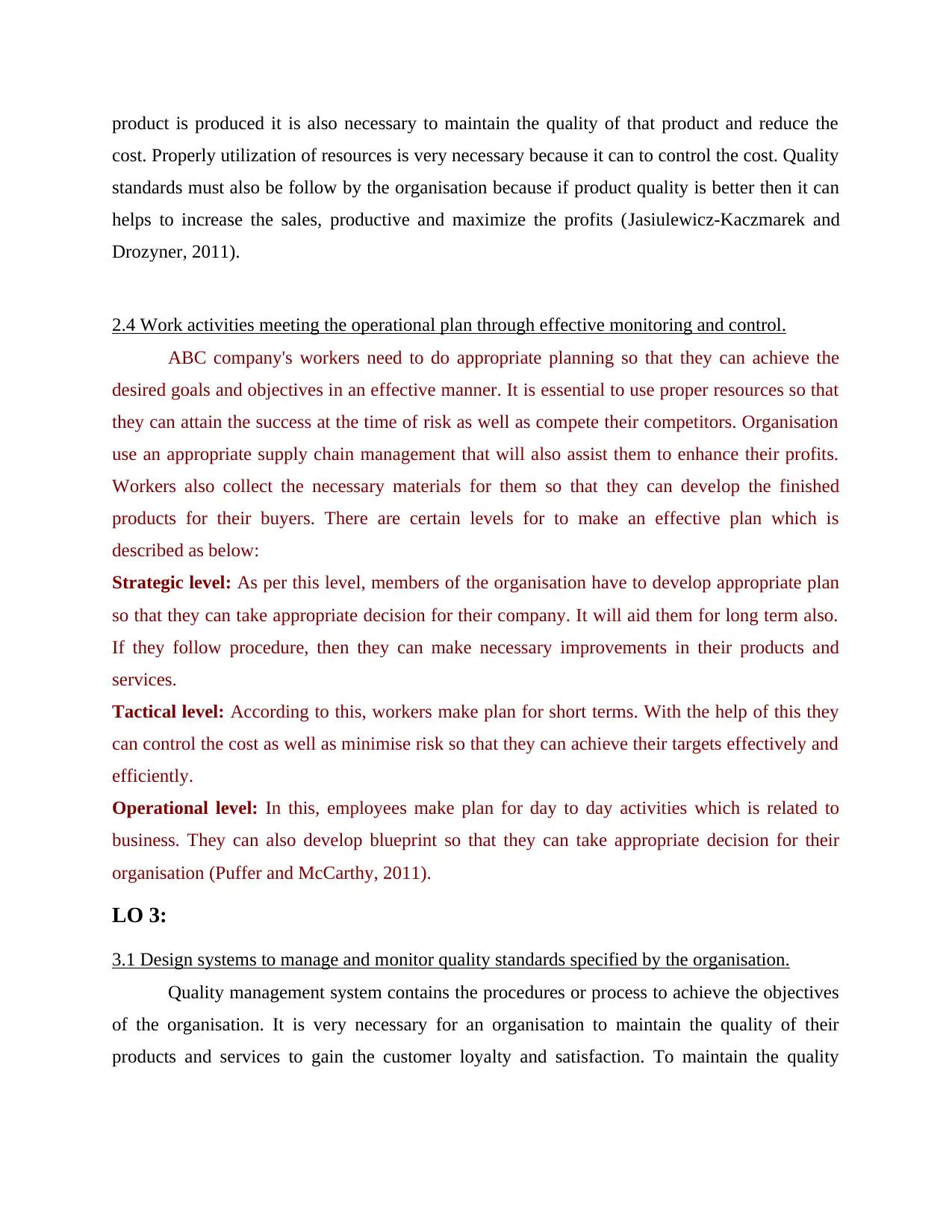
product is produced it is also necessary to maintain the quality of that product and reduce the
cost. Properly utilization of resources is very necessary because it can to control the cost. Quality
standards must also be follow by the organisation because if product quality is better then it can
helps to increase the sales, productive and maximize the profits (Jasiulewicz-Kaczmarek and
Drozyner, 2011).
2.4 Work activities meeting the operational plan through effective monitoring and control.
ABC company's workers need to do appropriate planning so that they can achieve the
desired goals and objectives in an effective manner. It is essential to use proper resources so that
they can attain the success at the time of risk as well as compete their competitors. Organisation
use an appropriate supply chain management that will also assist them to enhance their profits.
Workers also collect the necessary materials for them so that they can develop the finished
products for their buyers. There are certain levels for to make an effective plan which is
described as below:
Strategic level: As per this level, members of the organisation have to develop appropriate plan
so that they can take appropriate decision for their company. It will aid them for long term also.
If they follow procedure, then they can make necessary improvements in their products and
services.
Tactical level: According to this, workers make plan for short terms. With the help of this they
can control the cost as well as minimise risk so that they can achieve their targets effectively and
efficiently.
Operational level: In this, employees make plan for day to day activities which is related to
business. They can also develop blueprint so that they can take appropriate decision for their
organisation (Puffer and McCarthy, 2011).
LO 3:
3.1 Design systems to manage and monitor quality standards specified by the organisation.
Quality management system contains the procedures or process to achieve the objectives
of the organisation. It is very necessary for an organisation to maintain the quality of their
products and services to gain the customer loyalty and satisfaction. To maintain the quality
cost. Properly utilization of resources is very necessary because it can to control the cost. Quality
standards must also be follow by the organisation because if product quality is better then it can
helps to increase the sales, productive and maximize the profits (Jasiulewicz-Kaczmarek and
Drozyner, 2011).
2.4 Work activities meeting the operational plan through effective monitoring and control.
ABC company's workers need to do appropriate planning so that they can achieve the
desired goals and objectives in an effective manner. It is essential to use proper resources so that
they can attain the success at the time of risk as well as compete their competitors. Organisation
use an appropriate supply chain management that will also assist them to enhance their profits.
Workers also collect the necessary materials for them so that they can develop the finished
products for their buyers. There are certain levels for to make an effective plan which is
described as below:
Strategic level: As per this level, members of the organisation have to develop appropriate plan
so that they can take appropriate decision for their company. It will aid them for long term also.
If they follow procedure, then they can make necessary improvements in their products and
services.
Tactical level: According to this, workers make plan for short terms. With the help of this they
can control the cost as well as minimise risk so that they can achieve their targets effectively and
efficiently.
Operational level: In this, employees make plan for day to day activities which is related to
business. They can also develop blueprint so that they can take appropriate decision for their
organisation (Puffer and McCarthy, 2011).
LO 3:
3.1 Design systems to manage and monitor quality standards specified by the organisation.
Quality management system contains the procedures or process to achieve the objectives
of the organisation. It is very necessary for an organisation to maintain the quality of their
products and services to gain the customer loyalty and satisfaction. To maintain the quality
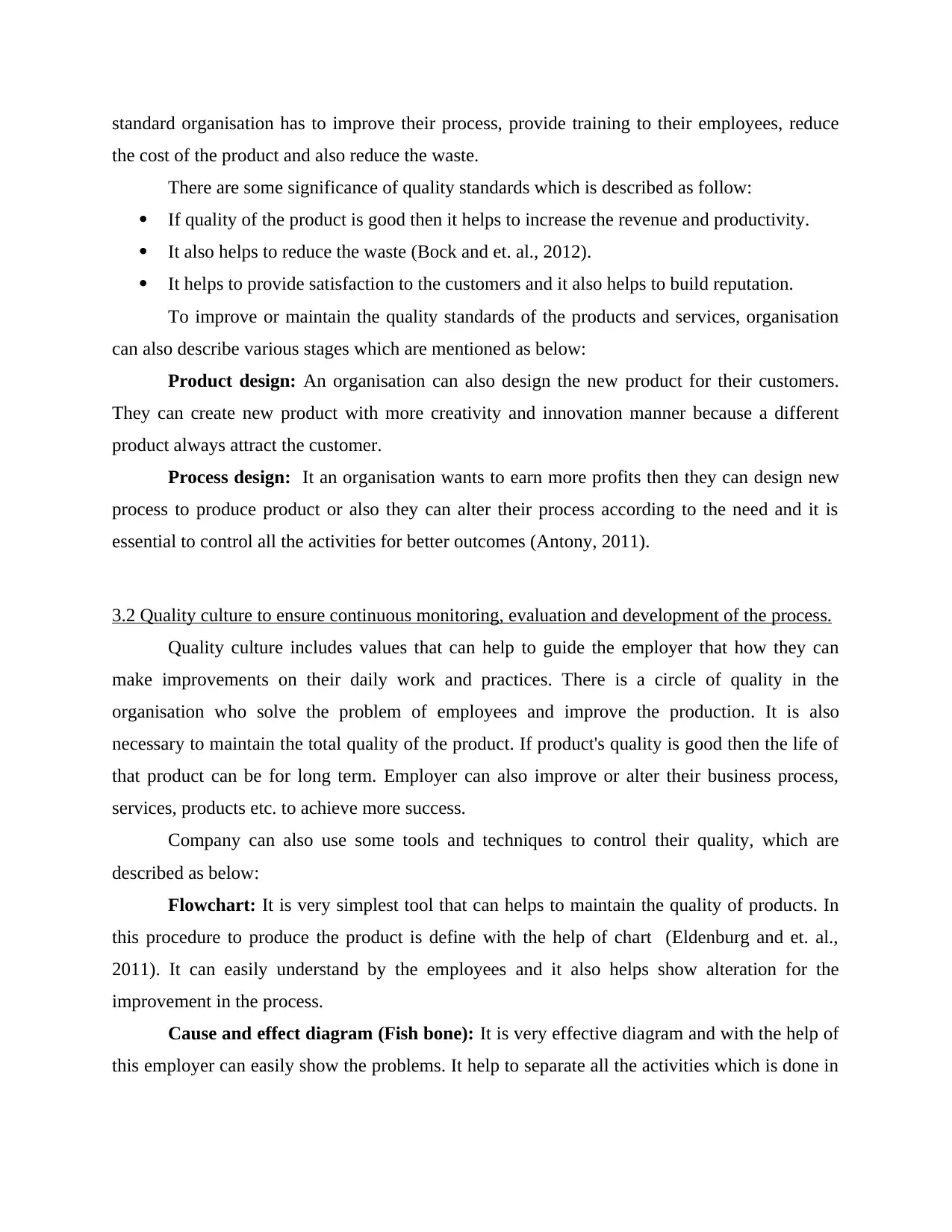
standard organisation has to improve their process, provide training to their employees, reduce
the cost of the product and also reduce the waste.
There are some significance of quality standards which is described as follow:
If quality of the product is good then it helps to increase the revenue and productivity.
It also helps to reduce the waste (Bock and et. al., 2012).
It helps to provide satisfaction to the customers and it also helps to build reputation.
To improve or maintain the quality standards of the products and services, organisation
can also describe various stages which are mentioned as below:
Product design: An organisation can also design the new product for their customers.
They can create new product with more creativity and innovation manner because a different
product always attract the customer.
Process design: It an organisation wants to earn more profits then they can design new
process to produce product or also they can alter their process according to the need and it is
essential to control all the activities for better outcomes (Antony, 2011).
3.2 Quality culture to ensure continuous monitoring, evaluation and development of the process.
Quality culture includes values that can help to guide the employer that how they can
make improvements on their daily work and practices. There is a circle of quality in the
organisation who solve the problem of employees and improve the production. It is also
necessary to maintain the total quality of the product. If product's quality is good then the life of
that product can be for long term. Employer can also improve or alter their business process,
services, products etc. to achieve more success.
Company can also use some tools and techniques to control their quality, which are
described as below:
Flowchart: It is very simplest tool that can helps to maintain the quality of products. In
this procedure to produce the product is define with the help of chart (Eldenburg and et. al.,
2011). It can easily understand by the employees and it also helps show alteration for the
improvement in the process.
Cause and effect diagram (Fish bone): It is very effective diagram and with the help of
this employer can easily show the problems. It help to separate all the activities which is done in
the cost of the product and also reduce the waste.
There are some significance of quality standards which is described as follow:
If quality of the product is good then it helps to increase the revenue and productivity.
It also helps to reduce the waste (Bock and et. al., 2012).
It helps to provide satisfaction to the customers and it also helps to build reputation.
To improve or maintain the quality standards of the products and services, organisation
can also describe various stages which are mentioned as below:
Product design: An organisation can also design the new product for their customers.
They can create new product with more creativity and innovation manner because a different
product always attract the customer.
Process design: It an organisation wants to earn more profits then they can design new
process to produce product or also they can alter their process according to the need and it is
essential to control all the activities for better outcomes (Antony, 2011).
3.2 Quality culture to ensure continuous monitoring, evaluation and development of the process.
Quality culture includes values that can help to guide the employer that how they can
make improvements on their daily work and practices. There is a circle of quality in the
organisation who solve the problem of employees and improve the production. It is also
necessary to maintain the total quality of the product. If product's quality is good then the life of
that product can be for long term. Employer can also improve or alter their business process,
services, products etc. to achieve more success.
Company can also use some tools and techniques to control their quality, which are
described as below:
Flowchart: It is very simplest tool that can helps to maintain the quality of products. In
this procedure to produce the product is define with the help of chart (Eldenburg and et. al.,
2011). It can easily understand by the employees and it also helps show alteration for the
improvement in the process.
Cause and effect diagram (Fish bone): It is very effective diagram and with the help of
this employer can easily show the problems. It help to separate all the activities which is done in
⊘ This is a preview!⊘
Do you want full access?
Subscribe today to unlock all pages.

Trusted by 1+ million students worldwide
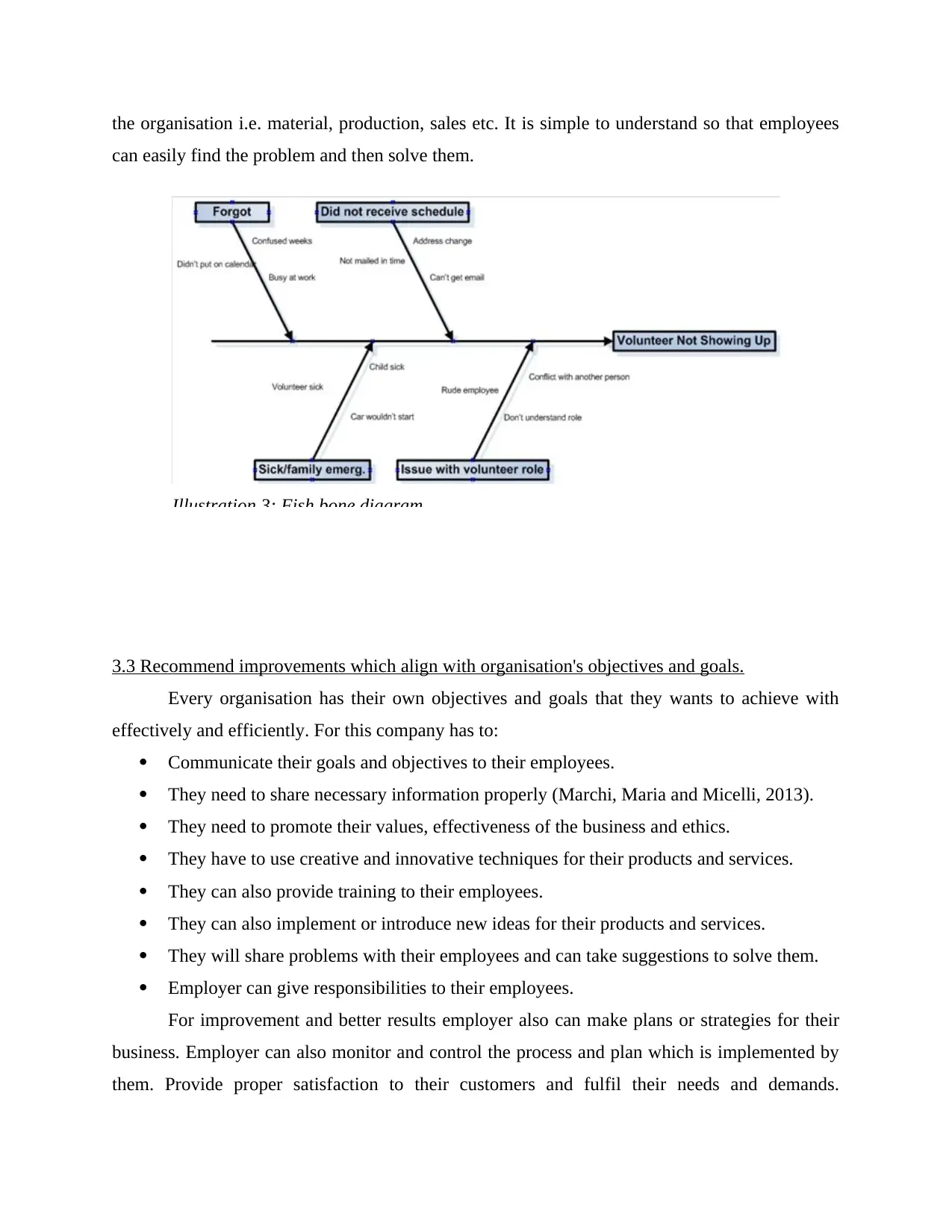
the organisation i.e. material, production, sales etc. It is simple to understand so that employees
can easily find the problem and then solve them.
3.3 Recommend improvements which align with organisation's objectives and goals.
Every organisation has their own objectives and goals that they wants to achieve with
effectively and efficiently. For this company has to:
Communicate their goals and objectives to their employees.
They need to share necessary information properly (Marchi, Maria and Micelli, 2013).
They need to promote their values, effectiveness of the business and ethics.
They have to use creative and innovative techniques for their products and services.
They can also provide training to their employees.
They can also implement or introduce new ideas for their products and services.
They will share problems with their employees and can take suggestions to solve them.
Employer can give responsibilities to their employees.
For improvement and better results employer also can make plans or strategies for their
business. Employer can also monitor and control the process and plan which is implemented by
them. Provide proper satisfaction to their customers and fulfil their needs and demands.
Illustration 3: Fish bone diagram
can easily find the problem and then solve them.
3.3 Recommend improvements which align with organisation's objectives and goals.
Every organisation has their own objectives and goals that they wants to achieve with
effectively and efficiently. For this company has to:
Communicate their goals and objectives to their employees.
They need to share necessary information properly (Marchi, Maria and Micelli, 2013).
They need to promote their values, effectiveness of the business and ethics.
They have to use creative and innovative techniques for their products and services.
They can also provide training to their employees.
They can also implement or introduce new ideas for their products and services.
They will share problems with their employees and can take suggestions to solve them.
Employer can give responsibilities to their employees.
For improvement and better results employer also can make plans or strategies for their
business. Employer can also monitor and control the process and plan which is implemented by
them. Provide proper satisfaction to their customers and fulfil their needs and demands.
Illustration 3: Fish bone diagram
Paraphrase This Document
Need a fresh take? Get an instant paraphrase of this document with our AI Paraphraser
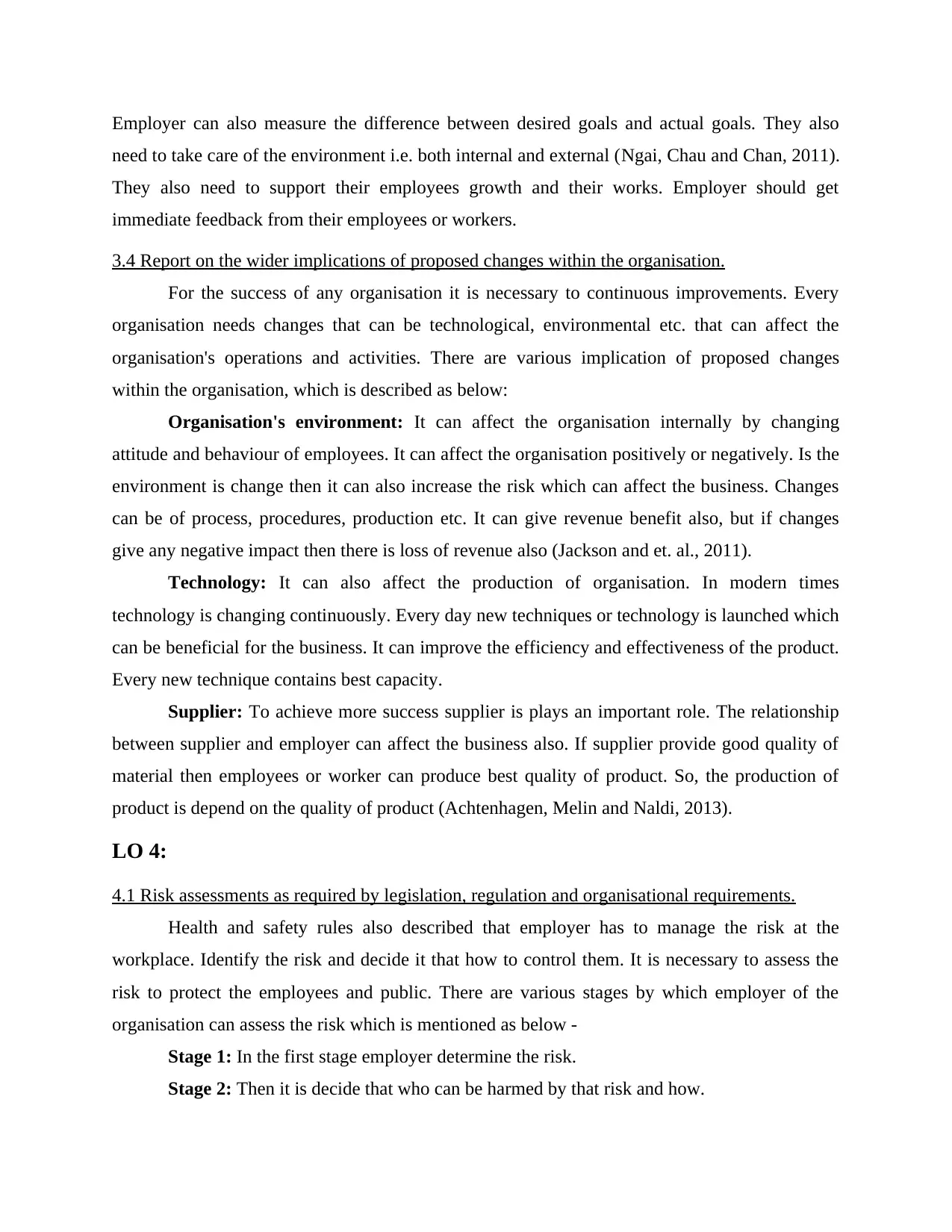
Employer can also measure the difference between desired goals and actual goals. They also
need to take care of the environment i.e. both internal and external (Ngai, Chau and Chan, 2011).
They also need to support their employees growth and their works. Employer should get
immediate feedback from their employees or workers.
3.4 Report on the wider implications of proposed changes within the organisation.
For the success of any organisation it is necessary to continuous improvements. Every
organisation needs changes that can be technological, environmental etc. that can affect the
organisation's operations and activities. There are various implication of proposed changes
within the organisation, which is described as below:
Organisation's environment: It can affect the organisation internally by changing
attitude and behaviour of employees. It can affect the organisation positively or negatively. Is the
environment is change then it can also increase the risk which can affect the business. Changes
can be of process, procedures, production etc. It can give revenue benefit also, but if changes
give any negative impact then there is loss of revenue also (Jackson and et. al., 2011).
Technology: It can also affect the production of organisation. In modern times
technology is changing continuously. Every day new techniques or technology is launched which
can be beneficial for the business. It can improve the efficiency and effectiveness of the product.
Every new technique contains best capacity.
Supplier: To achieve more success supplier is plays an important role. The relationship
between supplier and employer can affect the business also. If supplier provide good quality of
material then employees or worker can produce best quality of product. So, the production of
product is depend on the quality of product (Achtenhagen, Melin and Naldi, 2013).
LO 4:
4.1 Risk assessments as required by legislation, regulation and organisational requirements.
Health and safety rules also described that employer has to manage the risk at the
workplace. Identify the risk and decide it that how to control them. It is necessary to assess the
risk to protect the employees and public. There are various stages by which employer of the
organisation can assess the risk which is mentioned as below -
Stage 1: In the first stage employer determine the risk.
Stage 2: Then it is decide that who can be harmed by that risk and how.
need to take care of the environment i.e. both internal and external (Ngai, Chau and Chan, 2011).
They also need to support their employees growth and their works. Employer should get
immediate feedback from their employees or workers.
3.4 Report on the wider implications of proposed changes within the organisation.
For the success of any organisation it is necessary to continuous improvements. Every
organisation needs changes that can be technological, environmental etc. that can affect the
organisation's operations and activities. There are various implication of proposed changes
within the organisation, which is described as below:
Organisation's environment: It can affect the organisation internally by changing
attitude and behaviour of employees. It can affect the organisation positively or negatively. Is the
environment is change then it can also increase the risk which can affect the business. Changes
can be of process, procedures, production etc. It can give revenue benefit also, but if changes
give any negative impact then there is loss of revenue also (Jackson and et. al., 2011).
Technology: It can also affect the production of organisation. In modern times
technology is changing continuously. Every day new techniques or technology is launched which
can be beneficial for the business. It can improve the efficiency and effectiveness of the product.
Every new technique contains best capacity.
Supplier: To achieve more success supplier is plays an important role. The relationship
between supplier and employer can affect the business also. If supplier provide good quality of
material then employees or worker can produce best quality of product. So, the production of
product is depend on the quality of product (Achtenhagen, Melin and Naldi, 2013).
LO 4:
4.1 Risk assessments as required by legislation, regulation and organisational requirements.
Health and safety rules also described that employer has to manage the risk at the
workplace. Identify the risk and decide it that how to control them. It is necessary to assess the
risk to protect the employees and public. There are various stages by which employer of the
organisation can assess the risk which is mentioned as below -
Stage 1: In the first stage employer determine the risk.
Stage 2: Then it is decide that who can be harmed by that risk and how.
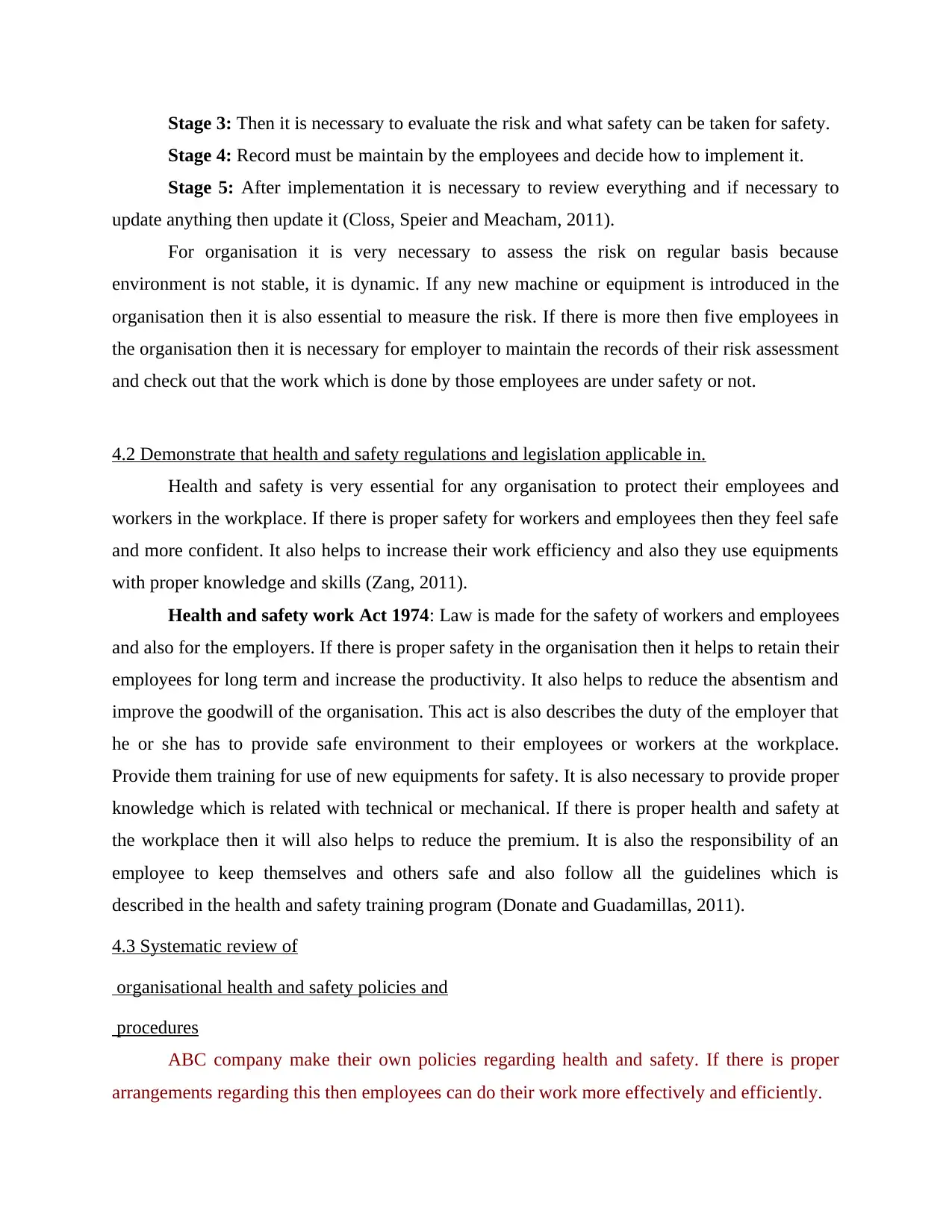
Stage 3: Then it is necessary to evaluate the risk and what safety can be taken for safety.
Stage 4: Record must be maintain by the employees and decide how to implement it.
Stage 5: After implementation it is necessary to review everything and if necessary to
update anything then update it (Closs, Speier and Meacham, 2011).
For organisation it is very necessary to assess the risk on regular basis because
environment is not stable, it is dynamic. If any new machine or equipment is introduced in the
organisation then it is also essential to measure the risk. If there is more then five employees in
the organisation then it is necessary for employer to maintain the records of their risk assessment
and check out that the work which is done by those employees are under safety or not.
4.2 Demonstrate that health and safety regulations and legislation applicable in.
Health and safety is very essential for any organisation to protect their employees and
workers in the workplace. If there is proper safety for workers and employees then they feel safe
and more confident. It also helps to increase their work efficiency and also they use equipments
with proper knowledge and skills (Zang, 2011).
Health and safety work Act 1974: Law is made for the safety of workers and employees
and also for the employers. If there is proper safety in the organisation then it helps to retain their
employees for long term and increase the productivity. It also helps to reduce the absentism and
improve the goodwill of the organisation. This act is also describes the duty of the employer that
he or she has to provide safe environment to their employees or workers at the workplace.
Provide them training for use of new equipments for safety. It is also necessary to provide proper
knowledge which is related with technical or mechanical. If there is proper health and safety at
the workplace then it will also helps to reduce the premium. It is also the responsibility of an
employee to keep themselves and others safe and also follow all the guidelines which is
described in the health and safety training program (Donate and Guadamillas, 2011).
4.3 Systematic review of
organisational health and safety policies and
procedures
ABC company make their own policies regarding health and safety. If there is proper
arrangements regarding this then employees can do their work more effectively and efficiently.
Stage 4: Record must be maintain by the employees and decide how to implement it.
Stage 5: After implementation it is necessary to review everything and if necessary to
update anything then update it (Closs, Speier and Meacham, 2011).
For organisation it is very necessary to assess the risk on regular basis because
environment is not stable, it is dynamic. If any new machine or equipment is introduced in the
organisation then it is also essential to measure the risk. If there is more then five employees in
the organisation then it is necessary for employer to maintain the records of their risk assessment
and check out that the work which is done by those employees are under safety or not.
4.2 Demonstrate that health and safety regulations and legislation applicable in.
Health and safety is very essential for any organisation to protect their employees and
workers in the workplace. If there is proper safety for workers and employees then they feel safe
and more confident. It also helps to increase their work efficiency and also they use equipments
with proper knowledge and skills (Zang, 2011).
Health and safety work Act 1974: Law is made for the safety of workers and employees
and also for the employers. If there is proper safety in the organisation then it helps to retain their
employees for long term and increase the productivity. It also helps to reduce the absentism and
improve the goodwill of the organisation. This act is also describes the duty of the employer that
he or she has to provide safe environment to their employees or workers at the workplace.
Provide them training for use of new equipments for safety. It is also necessary to provide proper
knowledge which is related with technical or mechanical. If there is proper health and safety at
the workplace then it will also helps to reduce the premium. It is also the responsibility of an
employee to keep themselves and others safe and also follow all the guidelines which is
described in the health and safety training program (Donate and Guadamillas, 2011).
4.3 Systematic review of
organisational health and safety policies and
procedures
ABC company make their own policies regarding health and safety. If there is proper
arrangements regarding this then employees can do their work more effectively and efficiently.
⊘ This is a preview!⊘
Do you want full access?
Subscribe today to unlock all pages.

Trusted by 1+ million students worldwide
1 out of 16
Related Documents
Your All-in-One AI-Powered Toolkit for Academic Success.
+13062052269
info@desklib.com
Available 24*7 on WhatsApp / Email
![[object Object]](/_next/static/media/star-bottom.7253800d.svg)
Unlock your academic potential
Copyright © 2020–2025 A2Z Services. All Rights Reserved. Developed and managed by ZUCOL.





